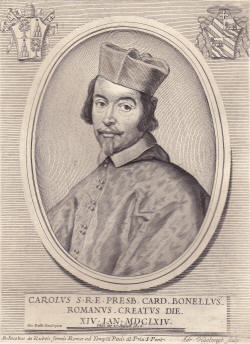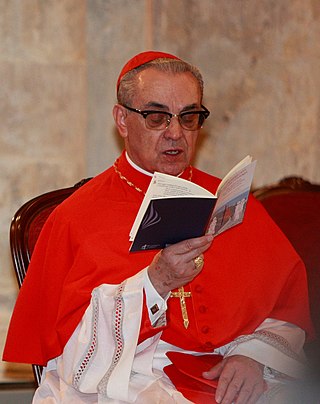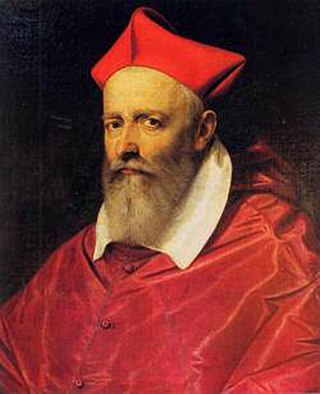The Roman Curia comprises the administrative institutions of the Holy See and the central body through which the affairs of the Roman Catholic Church are conducted. The Roman Curia is the institution which the Roman Pontiff ordinarily makes use of in the exercise of his supreme pastoral office and universal mission in the world. It is at the service of the Pope, successor of Peter, and of the Bishops, successors of the Apostles, according to the modalities that are proper to the nature of each one, fulfilling their function with an evangelical spirit, working for the good and at the service of communion, unity and edification of the Universal Church and attending to the demands of the world in which the Church is called to fulfill its mission.

The Camerlengo of the Holy Roman Church is an office of the papal household that administers the property and revenues of the Holy See. Formerly, his responsibilities included the fiscal administration of the Patrimony of Saint Peter. As regulated in the apostolic constitution Pastor bonus of 1988, the Camerlengo is always a cardinal, though this was not the case prior to the 15th century. His heraldic arms are ornamented with two keys – one gold, one silver – in saltire, surmounted by an ombrellino, a canopy or umbrella of alternating red and yellow stripes. These also form part of the coat of arms of the Holy See during a papal interregnum. The Camerlengo has been Kevin Farrell since his appointment by Pope Francis on 14 February 2019. The Vice Camerlengo has been Archbishop Ilson de Jesus Montanari since 1 May 2020.

Sede vacante is a term for the state of a/an (arch)diocese while without a/an (arch)bishop. In the canon law of the Catholic Church, the term is used to refer to the vacancy of the (arch)bishop's or Pope's authority upon his death or resignation.

Monsignor is a form of address or title for certain members of the clergy in the Catholic Church. Monsignor is the apocopic form of the Italian monsignore, meaning "my lord". "Monsignor" can be abbreviated as Mons. or Msgr. In some countries, the title "monsignor" is used as a form of address for bishops. However, in English-speaking countries, the title is unrelated to the episcopacy, though many priests with the title later become bishops.

A papal conclave is a gathering of the College of Cardinals convened to elect a bishop of Rome, also known as the pope. Catholics consider the pope to be the apostolic successor of Saint Peter and the earthly head of the Catholic Church.
The papal household or pontifical household, called until 1968 the Papal Court, consists of dignitaries who assist the pope in carrying out particular ceremonies of either a religious or a civil character.
The Apostolic Camera, formerly known as the Papal Treasury, was an office in the Roman Curia. It was the central board of finance in the papal administrative system and at one time was of great importance in the government of the States of the Church and in the administration of justice, led by the Camerlengo of the Holy Roman Church, originally known as camerarius (chamberlain).

Carlo Bonelli (1612–1676) was an Italian lawyer and diplomat who was appointed a cardinal of the Roman Catholic Church in 1664.

Girolamo Ghinucci was an Italian papal administrator, diplomat and cardinal in the Roman Catholic Church.

A chamberlain is a senior royal official in charge of managing a royal household. Historically, the chamberlain superintends the arrangement of domestic affairs and was often also charged with receiving and paying out money kept in the royal chamber. The position was usually awarded as an honour to a high-ranking member of the nobility (nobleman) or the clergy, often a royal favourite. Roman emperors appointed this officer under the title of cubicularius. The Chamberlain of the Holy Roman Church enjoys very extensive powers, having the revenues of the papal household under his charge. As a sign of their dignity, chamberlains bore a key, which in the seventeenth century was often silvered, and actually fitted the door-locks of chamber rooms. Since the eighteenth century, it has turned into a merely symbolic, albeit splendid, rank-insignia of gilded bronze. In many countries there are ceremonial posts associated with the household of the sovereign.

Ildebrando Antoniutti was an Italian cardinal of the Roman Catholic Church. He served as prefect of the Congregation for Religious from 1963 to 1973, and was elevated to the cardinalate by Pope John XXIII in 1962.
Alessandro Sanminiatelli Zabarella was an Italian cardinal of the Catholic Church. He served as Latin Patriarch of Constantinople from 1889 until 1901.

Pierre de Murat de Cros, O.S.B., was a French monk of aristocratic origins who became a cardinal of the Avignon Obedience during the Great Schism, as well as the Archbishop of Arles and the Chamberlain of the Apostolic Camera. Refusing from the day of his election to support Bartolomeo Prignano after the Papal Conclave of 1378, de Cros played a critical role in delivering a considerable portion of the Roman Curia to the rival claimant Robert of Geneva, who took the name Clement VII. Historian Daniel Williman calls Murat de Cros's actions a "counter-coup".

Paluzzo Paluzzi Altieri degli Albertoni was an Italian Catholic Cardinal and Cardinal-Nephew to Pope Clement X.

Pontificalis Domus was a motu proprio document issued by Pope Paul VI on 28 March 1968, in the fifth year of his pontificate. It reorganized the Papal Household, which had been known until then as the Papal Court.

Santos Abril y Castelló is a Spanish prelate of the Catholic Church. After a career in the diplomatic corps of the Holy See, he held a number of positions in the Roman Curia and from 2011 to 2016 was Archpriest of the Basilica of Santa Maria Maggiore.

Bartolomeo Roverella (1406–1476) was an Italian Roman Catholic Bishop and cardinal.

Giacomo Savelli (1523–1587) was an Italian Roman Catholic cardinal and bishop. He participated in several papal conclaves and held several administrative positions in the Catholic Church during his 48 year career with the Church during the mid 16th century.

Giovanni Ricci was an Italian Roman Catholic bishop and cardinal.

Girolamo Rusticucci was an Italian Roman Catholic cardinal and bishop. He was personal secretary to Cardinal Michele Ghislieri, later Pope Pius V, who made Rusticucci a cardinal. He occupied numerous important positions, including papal legate to France and Spain, Camerlengo (treasurer) and Vice-Dean of the College of Cardinals, and Vicar General of Rome.













